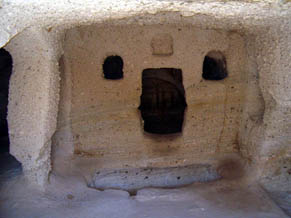
Near the village of Tripiti, on a steep slope, are the catacombs of Milos. Gathering place of the first Christians, for the performance of their religious duties and the burial of their dead. They are unique in size in the Greek area and among the most remarkable, along with those of Rome and the Holy Land, at a global level. They were first discovered by antiquarians and became known after they were violated in 1840. There are three in total and together with five corridors and a funeral chamber they form a labyrinthine system with a total length of 185 meters. It had external entrances, but today only that of the second catacomb or "Elders", from which the visitor can enter, is in operation. Inside the catacombs, right and left on the walls, there are the "arcosoli" (excavated pits like arches). Among them, as well as on the floor, the graves were opened. Today, 126 arcosoli are preserved. It is estimated that thousands of dead had been buried. Christian symbols were painted or inscriptions engraved on the graves of the most distinguished persons. One such inscription exists in the second catacomb and is the inscription of the "Elders", hence its name. In the same catacomb there is a tomb dug into the rock in the form of a sarcophagus. Probably one of the first Christian martyrs was buried here and the first Christians used it as a Holy Altar in their liturgies. Activity in the catacombs ceases shortly after the institution of secularism (the Milan decree), and until the ancient city of Klima is destroyed and abandoned by earthquakes in the 5th or 6th century AD. Today, 126 arcosoli are preserved. It is estimated that thousands of dead had been buried. Christian symbols were painted or inscriptions engraved on the graves of the most distinguished persons. One such inscription exists in the second catacomb and is the inscription of the "Elders", hence its name. In the same catacomb there is a tomb dug into the rock in the form of a sarcophagus. Probably one of the first Christian martyrs was buried here and the first Christians used it as a Holy Altar in their liturgies. Activity in the catacombs ceases shortly after the institution of secularism (the Milan decree), and until the ancient city of Klima is destroyed and abandoned by earthquakes in the 5th or 6th century AD. Today, 126 arcosoli are preserved. It is estimated that thousands of dead had been buried. Christian symbols were painted or inscriptions engraved on the graves of the most distinguished persons. One such inscription exists in the second catacomb and is the inscription of the "Elders", hence its name. In the same catacomb there is a tomb dug into the rock in the form of a sarcophagus. Probably one of the first Christian martyrs was buried here and the first Christians used it as a Holy Altar in their liturgies. Activity in the catacombs ceases shortly after the institution of secularism (the Milan decree), and until the ancient city of Klima is destroyed and abandoned by earthquakes in the 5th or 6th century AD. Christian symbols were painted or inscriptions engraved on the graves of the most distinguished persons. One such inscription exists in the second catacomb and is the inscription of the "Elders", hence its name. In the same catacomb there is a tomb dug into the rock in the form of a sarcophagus. Probably one of the first Christian martyrs was buried here and the first Christians used it as a Holy Altar in their liturgies. Activity in the catacombs ceases shortly after the institution of secularism (the Milan decree), and until the ancient city of Klima is destroyed and abandoned by earthquakes in the 5th or 6th century AD. Christian symbols were painted or inscriptions engraved on the graves of the most distinguished persons. One such inscription exists in the second catacomb and is the inscription of the "Elders", hence its name. In the same catacomb there is a tomb dug into the rock in the form of a sarcophagus. Probably one of the first Christian martyrs was buried here and the first Christians used it as a Holy Altar in their liturgies. Activity in the catacombs ceases shortly after the institution of secularism (the Milan decree), and until the ancient city of Klima is destroyed and abandoned by earthquakes in the 5th or 6th century AD. In the same catacomb there is a tomb dug into the rock in the form of a sarcophagus. Probably one of the first Christian martyrs was buried here and the first Christians used it as a Holy Altar in their liturgies. Activity in the catacombs ceases shortly after the institution of secularism (the Milan decree), and until the ancient city of Klima is destroyed and abandoned by earthquakes in the 5th or 6th century AD. In the same catacomb there is a tomb dug into the rock in the form of a sarcophagus. Probably one of the first Christian martyrs was buried here and the first Christians used it as a Holy Altar in their liturgies. Activity in the catacombs ceases shortly after the institution of secularism (the Milan decree), and until the ancient city of Klima is destroyed and abandoned by earthquakes in the 5th or 6th century AD.
Editor: Fotini Anastasopoulou